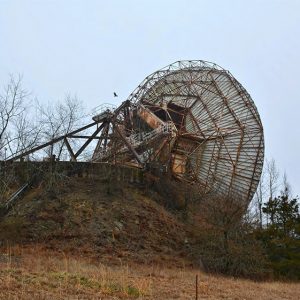calsfoundation@cals.org
Arkansas Research and Test Station
The Arkansas Research and Test Station site in Montgomery County near Hopper (Montgomery County) was one of two stations constructed in the United States in the early 1960s capable of transmitting communications to satellites orbiting the Earth. Constructed in 1965–66 and in operation until 1969, it was added to the National Register of Historic Places on September 21, 2017. The exact location of the site is restricted.
The site was constructed by the Hughes Aircraft Company, founded by Howard Hughes. After initial efforts to place the site near Fayetteville (Washington County) to work with the University of Arkansas (UA) failed, the company struggled to find a suitable location. A location was finally chosen in rural Montgomery County that was located far enough from any population centers that could create microwave interference with the project. The entire site encompasses slightly more than eleven and a half acres.
Construction began almost immediately after the location was selected. The site consists of two structures: an eighty-five-foot-diameter paraboloid antenna and a control building. The antenna is located on top of a forty-five-foot pedestal.
The one-story control building is utilitarian in design. Resting on a cast-concrete foundation, the exterior and interior walls are constructed from concrete blocks. The roof is supported by flat warren trusses and covered with foam roof decking topped with two layers of silicone. Due to the flat roof, the building has many leaks.
The building faces south, and this side of the structure has three bays. The front door is located in the recessed right bay and surrounded by plate-glass windows with a plate-glass door. The center bay is not recessed and the left bay is recessed, although only half as much as the right bay. The left bay includes several spandrel and single-pane glass panels. The center bay does not include any ornamentation. A single Warren truss is visible on the front of the building, with all of the other trusses located inside of the structure.
The west side of the building contains two sets of original double steel doors with a window transom. Another single door was added later, and a large garage style door is also located on this side of the building. Both the north and east sides of the building are unornamented.
The site remains much the same as it appeared during the operational period of the facility. The only changes that have been made to the site are the removal of the wiring on the antenna and the removal of the computer equipment from the building.
The importance of this building to the development of satellite communications cannot be understated. Only one other similar structure was built in this period, in Andover, Maine.
For additional information:
“Arkansas Research and Test Station.” National Register of Historic Places registration form. On file at Arkansas Historic Preservation Office, Little Rock, Arkansas. Online at http://www.arkansaspreservation.com/National-Register-Listings/PDF/MN0069_Redacted.pdf (accessed February 8, 2020).
Ratermann, Travis. “Arkansas Listings on the National Register of Historic Places.” Arkansas Historical Quarterly 78 (Spring 2019): 206–213.
David Sesser
Henderson State University
 Historic Preservation
Historic Preservation Science and Technology
Science and Technology World War II through the Faubus Era, 1941 through 1967
World War II through the Faubus Era, 1941 through 1967 ARTS Antenna
ARTS Antenna  ARTS Antenna
ARTS Antenna  ARTS Building
ARTS Building  ARTS Building
ARTS Building 



I remember as a young teen growing up in Norman hearing about this. When a group of us finally were old enough to have motorcycles we searched and FINALLY found it. It was an astonishing thing to behold for a young man with scientific ambitions.